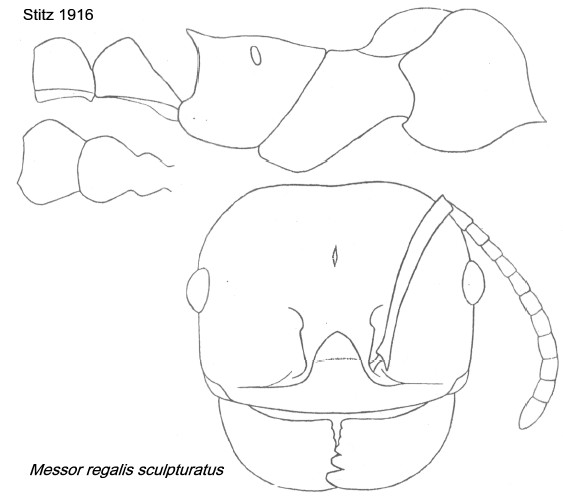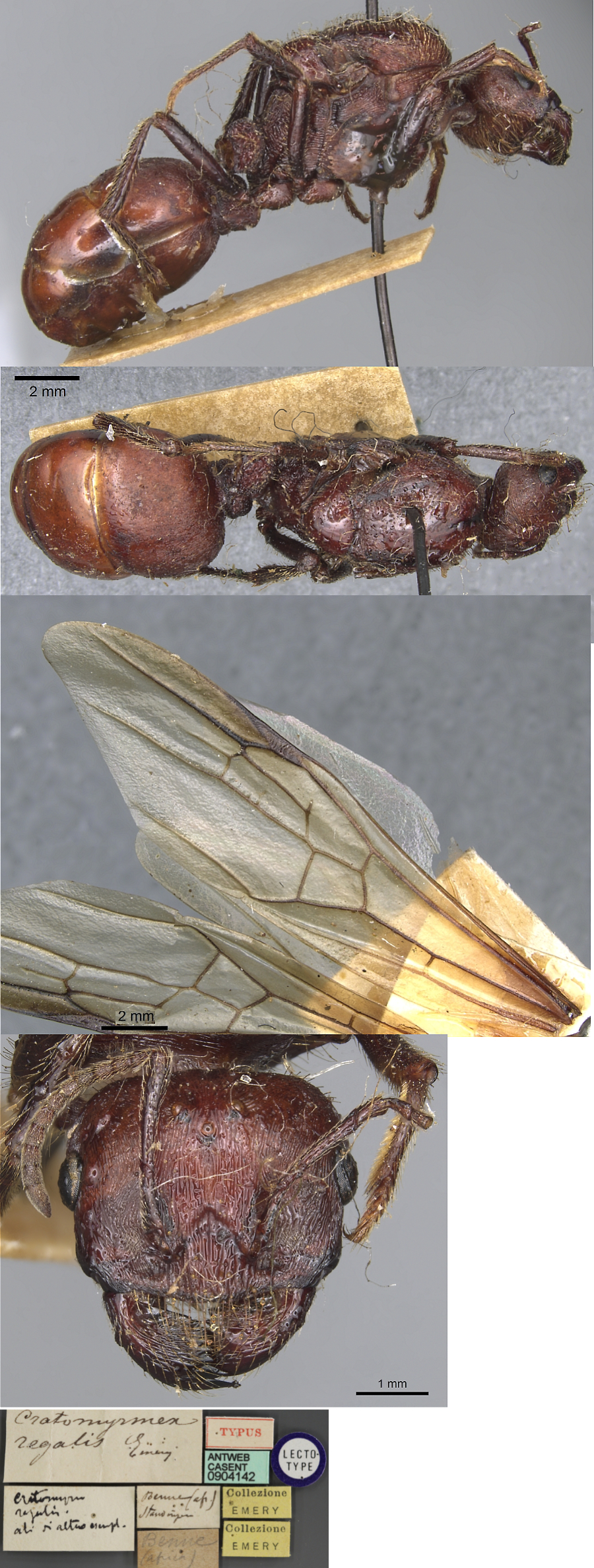Messor regalis (Emery)
  Type location Nigeria
(Cratomyrmex regalis n. sp., Emery, 1892d: 572, illustrated,
queen,
volume for 1891 but published in 1892; Santschi, 1913c: 307,
illustrated,worker) type from Benue, supplied by Staudinger & Bang
Haas, worker from Benin, middle Dahomey, Aguagua, collected by
Roubaud - see below Type location Nigeria
(Cratomyrmex regalis n. sp., Emery, 1892d: 572, illustrated,
queen,
volume for 1891 but published in 1892; Santschi, 1913c: 307,
illustrated,worker) type from Benue, supplied by Staudinger & Bang
Haas, worker from Benin, middle Dahomey, Aguagua, collected by
Roubaud - see below
junior synonyms
rubea (Cratomyrmex regalis Emery var. rubea v. nov., Santschi, 1913c:
308, worker)
from Benin, collected in Lower Dahomey, no location, by Le
Moult - see http://www.antweb.org/specimenImages.do?code=casent0913212
sculpturatus (Cratomyrmex
sculpturatus n. sp., Stitz, 1916: 377, illustrated, worker)
from Congo, collected at Fort de Possel to Fort Crampel, by
Schubotz - http://www.antweb.org/specimenImages.do?name=rmcaent000017749
(see Bolton, 1995)  . .
|
 Emery's
(1892d) description is at Emery's
(1892d) description is at  . Santschi's (1913c)
description of the
worker and of rubea is at . Santschi's (1913c)
description of the
worker and of rubea is at  ; his (1920d) placement of Cratomyrmex
as a subgenus of Messor is at ; his (1920d) placement of Cratomyrmex
as a subgenus of Messor is at  . Stizt's (1916) description of sculpturatus
is at . Stizt's (1916) description of sculpturatus
is at  . Bolton's modern description (1982) is at . Bolton's modern description (1982) is at  . .
|
 WORKER - HW 3.0 (medium) - > 4.5 (Bolton, 1982: 352,
not illustrated). TL ca 6-14 mm (J-m K). Dorsum of propodeum without
standing hairs; sides of head with projecting hairs in full-face view;
petiole and postpetiole coarsely, closely and deeply rugose. WORKER - HW 3.0 (medium) - > 4.5 (Bolton, 1982: 352,
not illustrated). TL ca 6-14 mm (J-m K). Dorsum of propodeum without
standing hairs; sides of head with projecting hairs in full-face view;
petiole and postpetiole coarsely, closely and deeply rugose.
In Bolton (1982) the reason for the type location
confusion is revealed as his denotation of a lectotype female from
Benue, Nigeria (collector Staudinger, no date, also in
Wheeler, 1922). Bolton fails to cite Santschi (1913c) as the descriptor
of the type worker, noting only the additional description of rubea;
other Nigeria collections were N. Bussa, Kano State (J.T. Medler),
Mokwa (C. Longhurst), and Olokemeji (Bridwell). Wheeler (1922) also
listed Nigeria collections at Lagos and Olokemeji (F. Silvestri); plus Benin
(Aguagua, by Roubaud).
Wheeler (1922) also had sculpturatus from Falls
of the Nana River near Fort Crampel, "Congo" = Central African
Republic, by Haberer.
Lévieux & Diomande (1982) reported findings on its
food sources in Ivory Coast, where it is a species of the Sudan
savannah in the north of the country. It forages over an area of
1300-1400 m² from the nest, is diurnally active with morning and
evening peaks, prefers covered ground, and mostly utilises a tall grass
species for its food.
|
 The photomontage of the
type queen is collated
from http://www.antweb.org/specimen.do?name=casent0904142. The photomontage of the
type queen is collated
from http://www.antweb.org/specimen.do?name=casent0904142.
|
 The photomontage of a worker from Nigeria, listed by
Bolton (1982: 352)
is collated
from http://www.antweb.org/specimen.do?name=casent0281586 The photomontage of a worker from Nigeria, listed by
Bolton (1982: 352)
is collated
from http://www.antweb.org/specimen.do?name=casent0281586
|
|